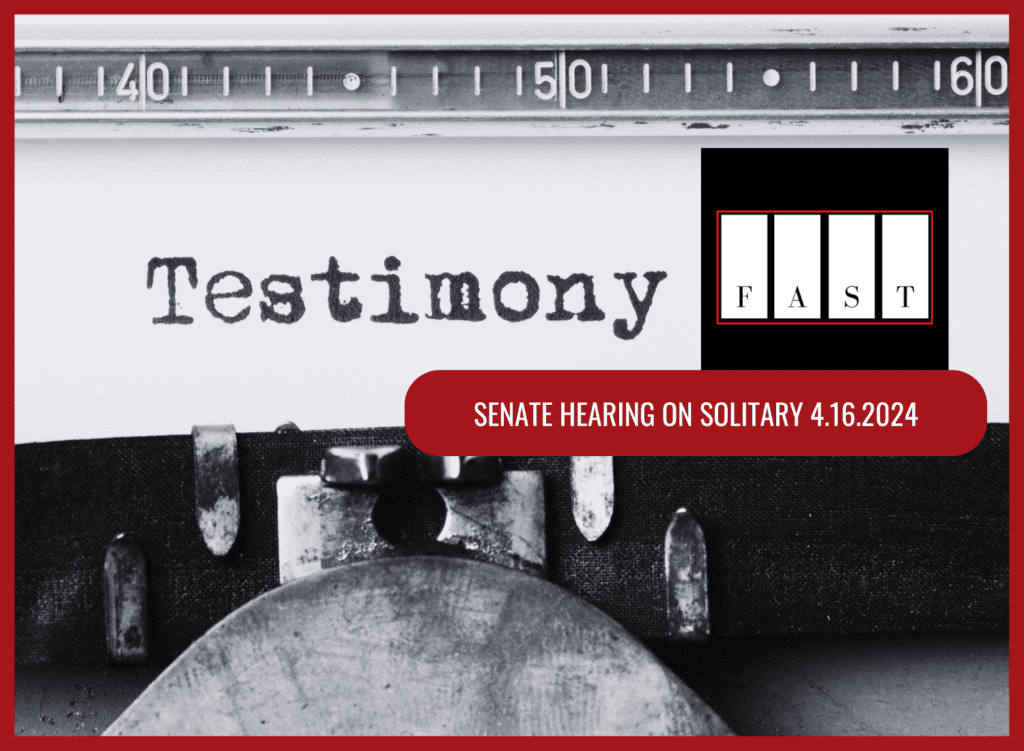Testimony by the Federal Anti-Solitary Taskforce
before the Senate Judiciary Committee
Regarding “Legacy of Harm: Eliminating the Abuse of Solitary Confinement”
April 16, 2024
The Federal Anti-Solitary Taskforce (FAST) thanks Chairperson Durbin and the Senate Judiciary Committee for holding this hearing on the urgent need to end solitary confinement.
Introduction
Solitary confinement is torture. It causes devastating physical and mental health harm, and leads to death. It worsens safety for everyone by causing people to deteriorate and making violence more likely – not less. Even short periods of time in solitary, measured in days and even hours, can cause devastating harm.
The use of solitary confinement at the federal level – including in Bureau of Prisons facilities and immigration detention – is beyond crisis levels. According to the recent Department of Justice (DOJ) Office of the Inspector General (OIG) report, nearly half of all deaths by suicide in BOP custody (46%) take place in restrictive housing — which are the BOP’s main form of solitary confinement — while people in restrictive housing represent approximately 8% of those in BOP custody. Meanwhile, another new report by the U.S. Government Accountability Office documents how the BOP sends people to solitary approximately 70,000 times a year and in a racially disproportionate manner, new investigative reporting documents the ongoing crisis of staff sexually assaulting women in BOP prisons and then locking them in solitary confinement as retaliation for reporting those assaults, and a new report documents the increased use of solitary confinement in federal immigration detention, with ICE locking people in solitary 14,000 times in the last five years including for months and years at a time.
These recent reports document a longstanding and worsening system of federal government abuse and torture. To urgently stop these horrific abuses, now is the moment for Congress and the President to enact the End Solitary Confinement Act, S3409/HR4972 in the U.S. Senate and House to finally end solitary confinement in all forms of federal custody and replace it with alternative forms of separation that are scientifically proven to reduce violence and better protect people’s health. The torture of solitary confinement has no place in the United States, and Congress and the President must end it now. The End Solitary Confinement Act is urgently needed to stop the torture of solitary confinement and improve the safety, health, and well-being of people incarcerated in federal custody, staff working in federal prisons and detention centers, and all of our outside communities.
The Federal Anti-Solitary Taskforce – convened by the ACLU, Center for Constitutional Rights, #HALTsolitary Campaign, National Religious Campaign Against Torture, Unlock the Box, Vera Institute of Justice, and Zealous – aims to end solitary confinement in all forms of federal custody, including in Bureau of Prisons facilities, immigration detention, and other sites of incarceration, as well as in states and localities across the country.
The Devastating and Deadly Harms of Solitary Confinement
Evidence has long shown solitary confinement causes devastating and deadly harm, worsens safety for everyone, and is inflicted disproportionately on Black people, Latina/o/x people, Native people, other people of color, and LGBTQ people.
Solitary causes people to engage in self-mutilation and suicide. It causes heart disease, anxiety, depression, and psychosis. Research shows even only one or two days in solitary leads to significantly heightened risk of death by accident, suicide, violence, overdose, and other causes. Even short periods of time in solitary measured in hours can cause devastating and deadly harm. On the day of her death in solitary confinement, Layleen Polanco had been locked in her cell for two or three hours before she died.
The fact that, according to the DOJ IG report, people in solitary confinement are nearly six times more likely to die by suicide than someone in the general federal prison population is unconscionable. It is, at the same time, not surprising, given that evidence has long shown that people in solitary confinement are five to six times more likely to die by suicide and seven to 12 times more likely to engage in self-harm than the rest of the prison, jail, or detention population – a population already at high risk of self-harm and death by suicide.
By making it more likely that people will act in a harmful way when solitary causes them to deteriorate, solitary also worsens, rather than improves, safety for everyone: incarcerated people, staff, and outside communities. Numerous studies, such as here and here, show people who have spent time in solitary or restrictive housing are more likely to be re-arrested after release from incarceration. The evidence is clear: what actually works to reduce violence is the exact opposite of solitary: pro-social program-based interventions involving full days of out-of-cell group engagement, like the CAPS/PACE programs as originally operated in NYC jails, the Merle Cooper Program in NYS, and the RSVP program in San Francisco jails. For example, the RSVP program included people who had carried out acts of assault, sexual assault, and other violent acts, and led to a precipitous drop in violence among participants to the point of having zero in-jail incidents over a one year period and reducing re-arrests for violence in the community by 83%. Best practices in youth and mental health facilities limit isolation to minutes or hours at most, with positive impacts on safety and people’s health and well-being.
Of note, double-celling individuals is not a solution to the challenges associated with solitary, the challenges of self-harm and suicide, or any related harms. Instead, double-celling creates additional risks and harms, for both people in general population and people in solitary confinement/restrictive housing. Regarding double-celled solitary — namely locking two people in isolation, often in a cell the size of a parking space for any length of time and in practice up to 23-24 hours a day — can have the same disastrous impact on an individual’s psychological health as single-cell solitary confinement, and can also lead to violence, especially when encouraged by the actions of corrections officers. Reporting by the Marshall Project and NPR and others have long documented the devastating and deadly harms of double-celled solitary. Such reporting also reveals that corrections officers are at the center of both directly inflicting and instigating violence and abuse. For instance, officers reportedly routinely spread rumors that endanger incarcerated individuals, incite violence, and force individuals to share cells with people they fear. Additionally, incarcerated individuals who have protested placement because they believe the other person in their cell to be dangerous, or have spoken out in protest about the conditions of the unit, have been placed in four-point restraints, the practice of shackling people by each limb on a bed for hours at a time.
Widespread Use of Solitary in Federal Custody
Despite the fact that solitary causes immense suffering and worsens safety, prisons, jails, and detention centers across the United States continue to daily lock over 122,000 people in solitary, including over 11,000 people in federal prisons alone. People are locked in solitary for days, weeks, months, years, and decades. Hundreds of thousands of people are locked in solitary over the course of a year, including over 70,000 times a year just in federal BOP prisons. ICE has also locked people in solitary confinement over 14,000 times in the last five years, including many for months at a time and for over a year.
While President Biden pledged to end solitary, while Bureau of Prisons Director Colette Peters has repeatedly reiterated the harms of solitary and the need to replace it with alternatives involving out-of-cell programs and human engagement, and while Attorney General Merrick Garland investigated its use, the number of people in solitary in federal prisons is still higher now than at the time of the President’s May 25, 2022 Executive Order calling for reductions in solitary.
The recent U.S. GAO report documented the continued widespread and racist infliction of solitary confinement in federal Bureau of Prisons facilities. Among other findings, the new GAO report documented that:
- Roughly 8% of people in federal prisons are locked in solitary confinement each day for upwards of 23 to 24 hours a day;
- BOP sent people to solitary over 70,000 times a year in the latest FY2022;
- BOP disproportionately locks Black people and other people of color in solitary – for example, “Black individuals constituted 38 percent of the total BOP population and 59 percent of the SMU placements”;
- BOP continues to lock people with “serious mental illness” in solitary; and
- Individuals in solitary in BOP custody raised complaints of “staff misconduct, denial of rights, and excessive use of force”.
The GAO found the Bureau of Prisons had even failed to implement over 62% of the basic recommendations from what are now 10 year old and 8 year old recommendations, respectively, by a BOP contractor in 2014 and the Department of Justice in 2016, despite a nearly two year old Executive Order by President Biden to, among other things, ensure full implementation of the DOJ’s 2016 recommendations. In response to the report, “BOP stated that it recognizes that restrictive housing is not an effective deterrent and can increase future recidivism.”
In addition to the GAO report, new investigative reporting documents the continuing practices of staff sexually assaulting women incarcerated in BOP prisons and then locking people in solitary confinement as retaliation for reporting such abuse. These ongoing horrific practices continue to happen even after other staff had been convicted of the same type of sexual abuse and after women had filed a class action lawsuit about these abuses. Following a court hearing in January where women testified about facing retaliation for reporting sexual abuse, those who testified were then retaliated against again for testifying in court by being placed in solitary confinement. As one woman reported, “I have been in custody at several federal facilities. It is the same everywhere: Women are being coerced into sex with staff. … I am watching [] women be abused by the system, by the same regional director’s employees that are supposed to be correcting things at Dublin. I was stunned that the employees were operating under the same playbook of punishing the victim, while they are in court alleging they have cleaned everything up. … They want to throw people in fear.”
The use of solitary confinement in immigration detention also continues to be devastating and deadly, and has increased. Physicians for Human Rights, the Harvard Law School Immigration and Refugee Clinic, and the Harvard University Peeler Immigration Lab recently issued a report, documenting the horrific increase in the use of solitary confinement in immigration detention. According to the report, ”In the last five years alone, ICE has placed people in solitary confinement over 14,000 times, with an average duration of 27 days. … 682 solitary confinement placements lasted at least 90 days, while 42 lasted over a year”. The consequences have been devastating and deadly. As one individual quoted in the report stated, “I have tried to kill myself three times already because of this endless nightmare and the consistent torture of solitary confinement.” The report’s principal recommendation to Congress is to: “Pass binding legislation banning the use of solitary confinement in immigration detention and legislation that will significantly decrease the number of people in immigration detention, including the End Solitary Confinement Act (H.R. 4972 / S.3409) and Dignity for Detained Immigrants Act (H.R. 2760 / S.1208).”
Congress and the President Must Enact the End Solitary Confinement Act
Particularly in light of these recent reports collectively providing a scathing indictment of the federal government’s widespread and deadly use of solitary confinement, Congress and the President must urgently act to end solitary confinement in order to stop torture, improve safety, and save lives. Specifically, the Senate and House must enact the End Solitary Confinement Act and the President must sign it into law. In the interim, the President must immediately take executive action to require BOP and ICE to adopt and implement the provisions of the End Solitary Confinement Act. Amongst other provisions, the End Solitary Confinement Act will make the following changes to stop torture, improve safety and health, and save lives.
1. End All Forms Of Solitary Confinement Beyond Four Hours
Because even short periods of time in solitary can cause devastating and deadly harm, and in line with best practices in youth and mental health settings and model programs in adult correctional settings, the Act will place a firm time limit on the use of solitary confinement of a maximum of four hours to de-escalate emergency situations involving imminent serious physical injury.
Best practices in youth and mental health facilities limit isolation to minutes or hours at most, with positive impacts on safety and people’s health and well-being. For example, the federal First Step Act fully banned the use of solitary/room confinement in youth facilities (defined as the “involuntary placement … alone in a cell, room, or other area for any reason”) other than for periods up to a maximum of 30 minutes in instances where there was a risk of self-harm and up to a maximum of three hours in instances where there was a risk of harm to others. The American Bar Association has urged an absolute maximum of four hours of such confinement for young people. Similarly, the leading expert on youth facility monitoring and assessments, the Juvenile Detention Alternatives Initiative (supported by the Annie E. Casey Foundation and in more than 250 sites in 39 states), has also said for a number of years that there should be an absolute maximum of 4 hours (p. 192) on such confinement because of the harm solitary/isolation can cause. As examples in practice, Colorado has reduced room confinement to the point of having an average duration of roughly one hour (with dramatic reduction in the number of times a person is placed in room confinement) and Massachusetts has an average duration of less than 40 minutes, with positive impacts on safety and well-being.
Similarly in adult mental health settings, over the last few decades there has been growing and now accelerated movement completely away from what was once a very widespread practice of solitary confinement (“seclusion”). For example, in Pennsylvania, in the 1990s, the state’s mental health hospitals dramatically restricted the use of seclusion to very few incidents with an average length of just over 1 hour, and in the 2000s they reduced it even further to the point of fully eliminating it, with reporting that there has been no use of seclusion in PA hospitals since 2013. The reductions in the use of seclusion (as well as reductions in the use of restraints) were correlated with fewer assaults by residents.
Of note, New York City recently enacted legislation prohibiting solitary beyond four hours in line with the provisions of the End Solitary Confinement Act. Also of note, while the End Solitary Confinement Act limits solitary to four hours, it still allows longer term separation – without isolation – of people from the general facility population into alternative units.
2. Allow Other Forms of Separation Scientifically Proven to Better Support Health and Reduce Violence
The End Solitary Confinement Act still allows people to be separated from the general facility population – they just can’t be isolated and tortured. Instead, the Act would promote the use of alternative forms of separation scientifically proven to reduce violence and better protect people’s health. To implement these types of proven alternatives, the Act will ensure that all people in federal custody, including in any form of separation/alternatives to solitary, regardless of what they are called, have access to at least 14 hours of daily out-of-cell time, with congregate, meaningful programming and activities.
As discussed above, that type of separation focused on pro-social program-based interventions involving full days of out-of-cell group programming and engagement – like the CAPS program as originally operated in NYC jails, the Merle Cooper Program in NYS, and the RSVP program in San Francisco jails – works much better at both reducing violence and supporting people’s health and well-being.
For example, the RSVP program included people who had carried out acts of assault, sexual assault, other violent acts, and repeated “heinous” acts. When the program was set to begin, staff protested that it would lead to riots and increases in violence. After the program was implemented, the location where the program was operating became the most sought after location in the jails by staff because it was the safest. After one month, the program led to a precipitous drop in violence among participants to the point of having zero incidents over a one year period. People who participated in the program also had dramatically lower rates of re-arrest for violent charges after release from jail.
Of note, the End Solitary Confinement Act will still allow people to be locked in their cells immediately following an incident for up to four hours and still allow much longer term separation in alternative units utilizing an approach scientifically proven to reduce violence and better protect people’s health.Such an approach will benefit both people incarcerated and staff who work in BOP and immigration detention facilities. According to Dr. James Giligan, who is the former director of Massachusetts prison mental health services and who has studied violence for decades, in his 2001 book Preventing Violence: “Far from preventing violence, punishment is the most powerful stimulus to violent behavior that we have yet discovered. Punishment does not prevent violence, it causes it, in addition to being a form of it.” Recalling his experience observing an incarceration setting, Dr. Gilligan wrote: “The more violent a person was, the more severely he would be punished, and the more severely he was punished, the more violent he would become. This endless, mutually self-defeating vicious circle kept both people incarcerated and prison officers in a chronic state of war with each other – which was the opposite of what they both said they wanted.”
Rather than continuing this endless cycle of harm and violence, the End Solitary Confinement Act would require a transformed approach that can actually reduce violence and improve health outcomes for both those who are incarcerated and those who work in these settings.
3. Enhance Due Process Protections
For people facing separation from the general facility population, the Act will ensure neutral decision-makers independent of BOP and ICE, allow representation at hearings, restrict conduct that can result in separation to the most egregious conduct in need of an intensive intervention, and impose strict time limits on any separation.
The processes that result in solitary confinement and other forms of restricted housing are often arbitrary, unfair, and infused with racial and other bias. People are also too often are sent to solitary confinement as retaliation for raising complaints and cover-up for abuse by staff. People facing the prospect of being separated from the general facility population should have the right to representation, including a right to appointed counsel, and should have a hearing before a neutral decision-maker who is not employed by the Bureau of Prisons, the U.S. Marshals Service, Department of Homeland Security, or other federal agencies with people in their care and custody. Other jurisdictions, such as Washington, D.C., Massachusetts, and New York State, allow access to representation. There also must be strict time limits on how long someone can remain in an alternative to solitary, to ensure that people do not get warehoused in units that may become abusive.
4. Create Oversight & Enforcement Mechanisms
The End Solitary Confinement Act will ensure a private cause of action for people to vindicate their rights, enhanced public data reporting, and oversight by the media and community stakeholders.
Including a private cause of action is necessary to ensure that people in custody who are wrongfully placed in solitary or restrictive housing and severely injured in violation of the Act and/or the Constitution are able to vindicate their rights and not precluded from having the ability to do so.
Extensive public reporting requirements on the use of solitary confinement and restrictive housing, enhanced media access, and community oversight will allow for at least some meaningful degree of oversight by the general public to shine a light on ongoing abusive practices and ensure that the Act is fully and properly implemented.
5. Incentivize States & Localities to End Solitary
The Act will ensure states and localities that receive relevant funding end solitary confinement in line with the provisions of the Act and instead utilize proven alternative forms of separation. As noted above and below, while a number of states and localities are helping lead the way toward ending solitary confinement, the practice remains widespread across the country. The End Solitary Confinement Act will allow the federal government to not only help lead the way toward replacing this torturous practice with scientifically proven alternatives but also directly incentivize states and localities to utilize this transformed approach.
Conclusion
A national poll shows broad bipartisan support for ending solitary confinement directly in line with the provisions of the End Solitary Confinement Act by a +32-point margin, with 78% of Democrats, 61% of Independents, and 51% of Republicans supporting it. A growing number of jurisdictions around the country are introducing legislation to end or limit solitary. New York City recently enacted legislation – with parallel provisions to the End Solitary Confinement Act – to end all solitary confinement beyond four hours immediately following an incident for purposes of emergency de-escalation, and require that all people in the jails, including all people in any alternatives to solitary confinement, have access to at least 14 hours of out-of-cell time with access to out-of-cell group programming and activities. States like New York, Colorado, North Dakota, New Jersey, Arizona, and Connecticut have all taken some meaningful steps in recent years aimed at significantly reducing the use of solitary confinement, although much more work is needed in those and other states to end all forms of solitary confinement.
The End Solitary Confinement Act draws from the best practices and policies to ban solitary beyond a maximum of four hours for emergency de-escalation, institute proven alternative forms of separation with access to 14 hours of daily out-of-cell group engagement, enhance due process protections, oversight, and the ability of incarcerated people to enforce their rights, and incentivize states and localities to do the same.
Over 180 organizations nationwide have already endorsed the End Solitary Confinement Act, including the NAACP, ACLU, the Advancement Project, LatinoJustice PRLDEF, Southern Center for Human Rights, National Disability Rights Network, and the Vera Institute, alongside leading human rights and racial justice experts, including members of the Federal Anti-Solitary Taskforce (FAST), These organizations are urging Congress and the President to act now to fulfill the President’s pledge to end solitary.
The Senate, the House, and the President now have the opportunity and obligation to finally end solitary confinement in federal custody. Now is the time to act before another person is tortured or another life is lost. We again thank Chair Durbin and the Senate Judiciary Committee for holding this hearing, and respectfully urge the Senate and House to pass the End Solitary Confinement Act. This hearing and the flurry of recent reports which continue to document the devastating infliction of solitary confinement must lead to concrete action to finally end solitary confinement once and for all and instead utilize alternative forms of separation proven to reduce violence and better support people’s health and wellbeing.
Unlock the Box is a coalition of organizations and movement leaders who partner with state and local campaigns across the United States with the common goal of ending the use of solitary confinement for all people. Unlock the Box pursues this goal by
working simultaneously on national, state, and local levels with solitary survivors, family
members, advocates, community and faith groups, legislators, healthcare and corrections experts, and others dedicated to ending state-sponsored torture.





